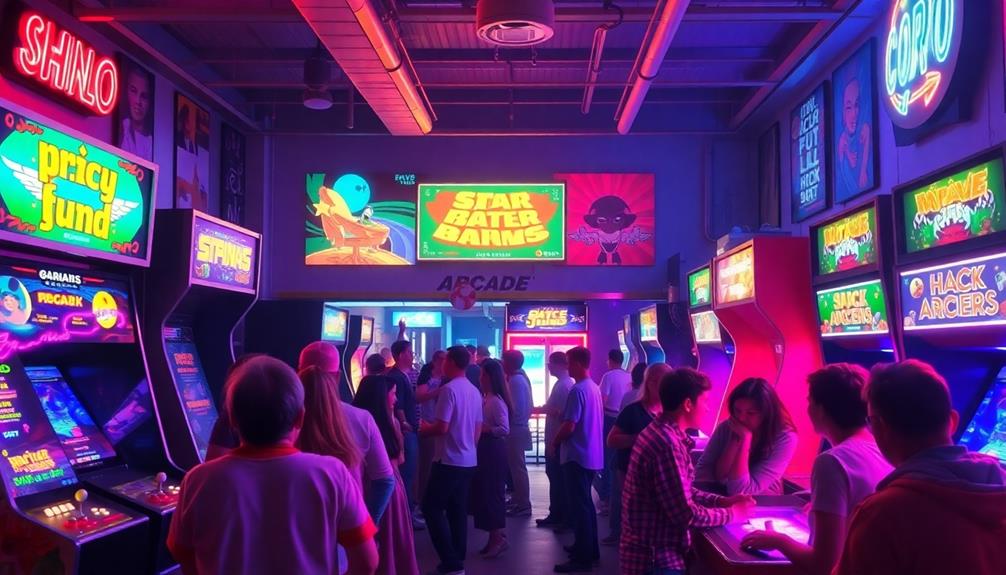You can find arcade games in various fun locations such as malls, family entertainment centers, and retro gaming bars. These games appeal to people of all ages, offering a combination of skill-based options like pinball and Skee-Ball, as well as chance-based favorites like slot machines. In the past, local arcades were often social hubs where friendships were formed while playing titles like Mortal Kombat or PAC MAN. Today, these arcades continue to evolve with advanced technology and unique experiences. If you’re interested in learning more about the types of arcade games and their intriguing history, stay tuned for additional insights!
Key Takeaways
- Arcade games can be found in various venues such as amusement parks, family entertainment centers, and dedicated arcade establishments.
- Many arcades are located in urban areas, often near shopping malls and entertainment districts.
- Some arcades offer a mix of classic and modern games, attracting a wide range of players.
- Online platforms have emerged, allowing players to enjoy arcade-style games from home.
- Local community events and festivals may host temporary arcade setups for entertainment.
Types of Arcade Games
Arcade games come in various types, each offering unique experiences that cater to different player preferences.
You'll find skill-based arcade games like pinball and Skee-Ball, where your ability directly impacts your success. These games challenge you to hone your skills for higher scores and rewards, and many enthusiasts enjoy customizing their machines with Addams Family pinball mods to enhance gameplay.
On the flip side, chance-based games rely on luck, adding an element of unpredictability that can be just as thrilling.
Electro-mechanical games, such as Periscope, combine electronic and mechanical components, providing a nostalgic experience.
Modern arcade video games began with the iconic Pong in the 1970s, paving the way for fighting games like Mortal Kombat and Street Fighter II, which are perfect for competitive play. Racing games, like Daytona USA, allow you to test your driving skills against friends, while puzzle games like Tetris challenge your quick thinking.
Redemption arcade games are particularly popular in family-friendly venues, rewarding players with tickets that can be exchanged for prizes.
Don't forget about Pachinko, a Japanese mechanical game that bridges the gap between arcade gaming and gambling.
Each type of arcade game presents a distinct experience, ensuring there's something for everyone.
Skill vs. Chance Dynamics
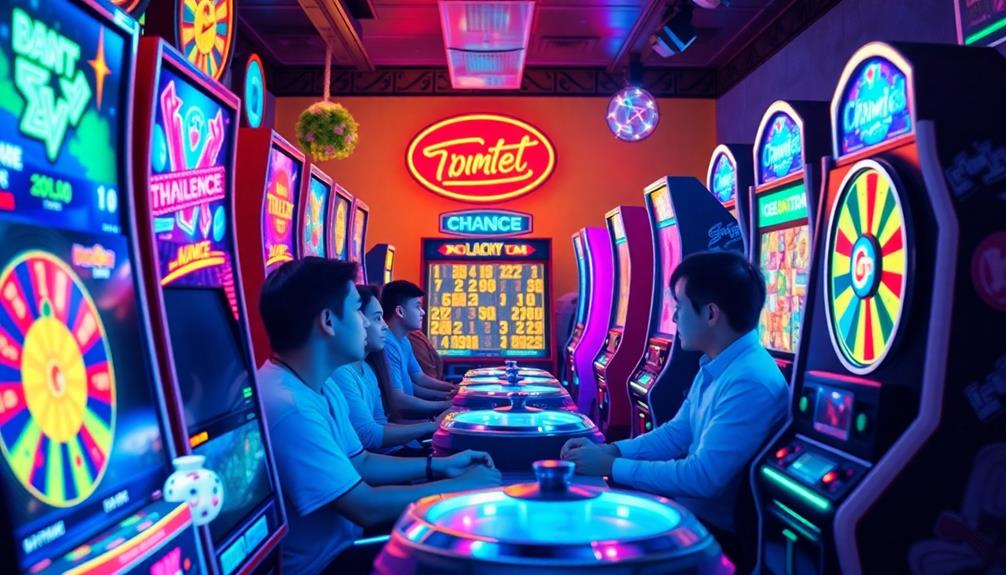
The dynamics of skill versus chance play a significant role in the charm of arcade games. You'll find that some arcade games, like Skee-Ball or pinball, rely heavily on your abilities, while others, such as slot machines, depend on luck. This distinction influences not only gameplay but also regulatory classifications.
Here's a quick breakdown of the types of arcade games:
| Game Type | Skill-Based | Chance-Based |
|---|---|---|
| Examples | Pinball, Skee-Ball | Slot Machines |
| Player Influence | High | Low |
| Regulatory Impact | Considered games of skill | Often viewed as gambling |
Take pinball, for instance. Initially classified as a game of chance, it shifted to skill-based after the introduction of the electric flipper in 1947. In Japan, pachinko blurs these lines by combining recreational and gambling aspects. Each game you play offers a unique blend of skill and chance, making arcade gaming a fascinating experience that keeps you coming back for more.
Historical Development Overview
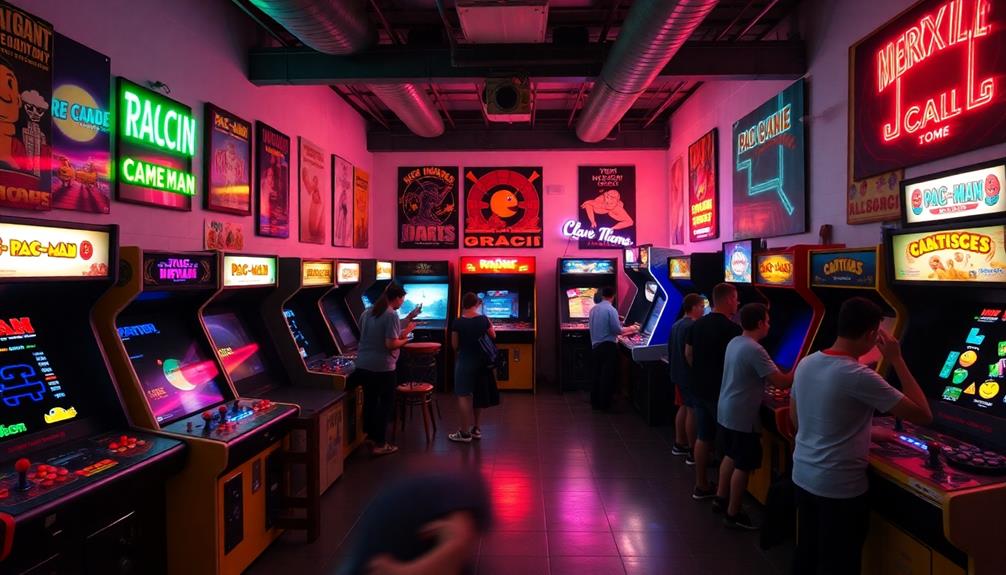
Arcade games started as skill-based attractions at fairs in the 19th century, evolving into the first coin-operated machines.
The introduction of pinball machines in the 1930s marked a significant milestone in arcade gaming, enchanting players with their mechanical interactions.
You'll see how technological advancements transformed these games, from the introduction of pinball in the 1930s to the vibrant 3D graphics of the early 1990s.
Let's explore how these developments shaped the arcade experience we understand today.
Origins of Arcade Games
Coin-operated machines have a rich history that traces back to the skill-based carnival games of the 19th century, which played an essential role in shaping the arcade gaming landscape.
These early games sparked the idea of rewarding players for their skills, setting the stage for what would become the arcade cabinet phenomenon. Remarkably, the cultural beliefs surrounding these games often intertwined with social interaction and self-image, enhancing their appeal among players astrology and attractiveness.
In 1933, pinball machines emerged, initially facing scrutiny as gambling devices. Many cities banned them, but this didn't deter their popularity.
As the late 1960s rolled in, the golden age of electro-mechanical games began, with innovations like Periscope (1965) enchanting players and pushing the boundaries of arcade gaming.
Then, the 1970s introduced arcade video games, with Pong's release in 1972 marking a significant turning point.
This simple yet addictive game led to a massive boom, flooding the market with clones and eventually resulting in a crash mid-decade.
Technological Advancements Over Time
As gaming evolved, technological advancements played a pivotal role in shaping the arcade experience. The journey began in the 19th century with simple mechanical devices, but the landscape changed dramatically with the arrival of Pong in 1972. This marked the birth of arcade video games, enchanting players with its electronic gameplay and leading to an era of uplifting music that accompanied many arcade experiences.
In 1947, the electric flipper revolutionized pinball machines, transforming them from gambling devices into skill-based games, leading to a resurgence in popularity.
The late 1960s ushered in a golden age for electro-mechanical games. The Periscope in 1965 showcased how mechanical gameplay could seamlessly blend with electronic features, setting the stage for future innovations.
Although the arcade industry faced a downturn in the mid-1970s due to an overwhelming number of Pong clones, it rebounded in the 1980s and early 1990s with advanced graphics and gameplay, highlighted by Street Fighter II.
The early 1990s brought a significant leap in technology with the rise of 3D graphics, exemplified by Virtua Racing. This innovation kept arcade machines competitive against home consoles, ensuring their place in gaming history until the late 1990s.
Technological Evolution in Arcades
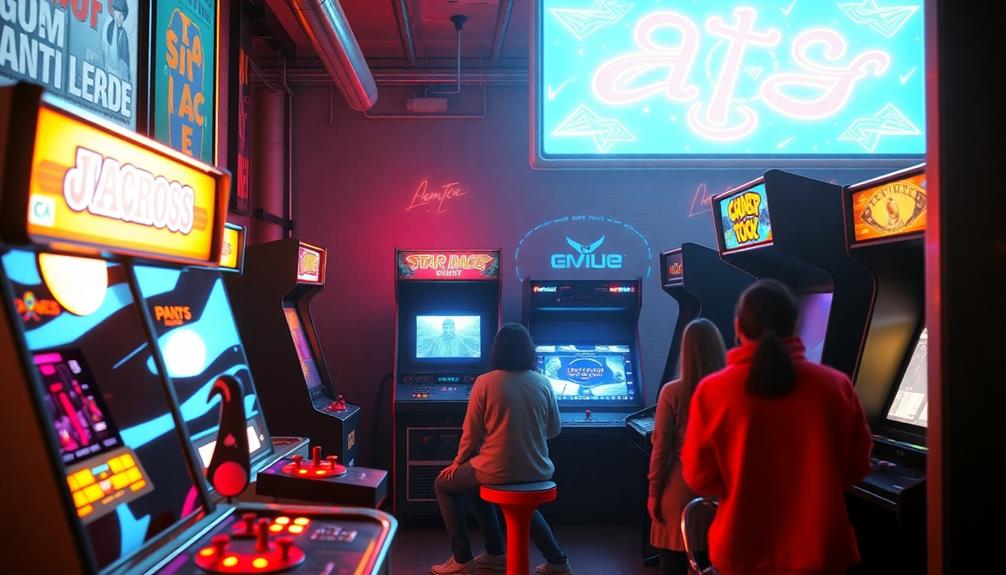
When you think about arcade evolution, it's clear that the shift to digital gaming began with groundbreaking titles like Pong.
This change set the stage for the emergence of 3D graphics in the early 1990s, which transformed the gaming landscape.
Innovations in AI technology, such as AI-powered personalized experiences, are now shaping how players interact with arcade games.
As you play, you can feel how these technological advancements have shaped your arcade experience.
Transition to Digital Gaming
The evolution of arcades into digital gaming hubs marked a pivotal shift in the gaming landscape. It all began with the introduction of Pong in 1972, which sparked a revolution in arcade video games.
By the 1980s, you witnessed an explosion of 8-bit and 16-bit games that enhanced graphics and sound, immersing players like never before. This era laid the foundation for what would become an incredible arcade collection, paralleling the excitement found in best rated pinball machines of 2024.
Key advancements in arcade gaming included:
- The rise of iconic titles like Pac-Man and Donkey Kong
- The introduction of more complex gameplay mechanics
- The shift from simple controls to multi-button configurations
- The emergence of competitive gaming and tournaments
- The continued innovation in game cabinets and designs
In the early 1990s, the introduction of 3D graphics with games like Virtua Racing set new gameplay standards.
By the late 1990s, systems like Sega Model 3 showcased technology that outperformed home consoles, keeping arcades relevant.
As the 2000s approached, motion simulation and virtual reality games continued to attract players, ensuring that arcades remained a crucial part of the gaming experience.
Emergence of 3D Graphics
Throughout the early 1990s, arcade gaming surged forward with the advent of 3D graphics, transforming how players experienced games. Titles like Virtua Racing and Virtua Fighter showcased advanced polygonal graphics, immersing you in dynamic environments. This evolution captivated a broader audience, pulling more players into arcades like never before.
As technology progressed, the growing demand for skilled professionals in areas like AI software engineering emerged, reflecting the broader trends in the gaming industry, as illustrated by the need for AI software engineer jobs that develop immersive gaming applications.
The Sega Model 3 arcade system, released in 1996, marked a significant milestone with its superior graphics and processing power. This technology allowed for complex, visually stunning games that outmatched earlier systems. As you stepped into these arcade experiences, you found yourself not just playing but interacting in ways previously unimaginable.
The introduction of 3D graphics didn't just enhance visuals; it spurred the development of specialized games, including motion simulation and virtual reality, designed to keep you engaged in a rapidly evolving gaming landscape.
Cultural Impact and Trends
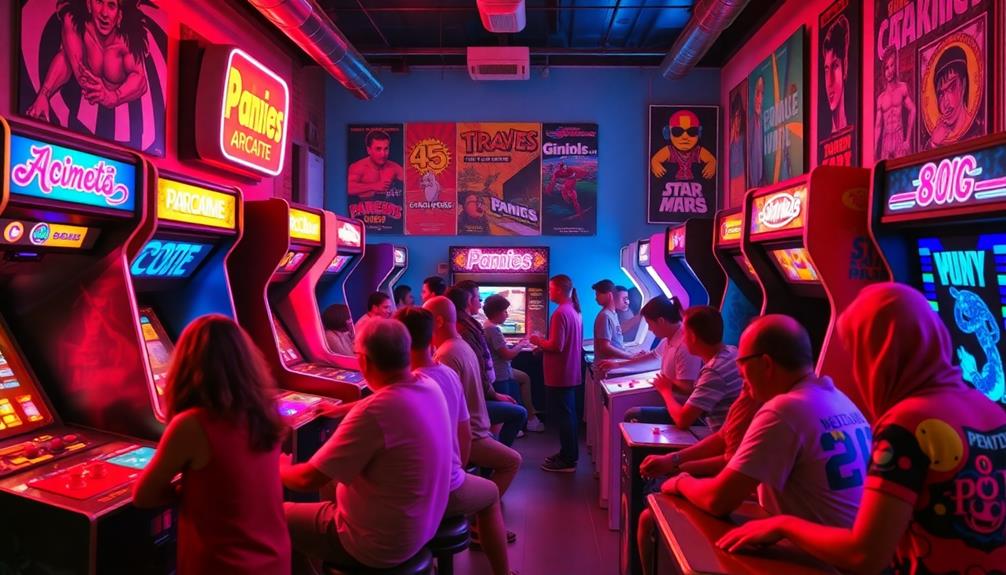
Arcade games have shaped social interactions and community dynamics, especially during their peak in the late 20th century. Remember those bustling game rooms filled with laughter and competition? Titles like Street Fighter II fostered friendships and rivalries, making players feel part of something larger. The excitement of competing with friends mirrors the thrill found in family-friendly attractions at water parks, where shared experiences create lasting memories.
However, as home gaming consoles became more popular, the arcade industry in Japan experienced a drastic decline, dropping from 26,000 arcades in 1986 to just 4,000 by 2019.
The COVID-19 pandemic further highlighted the industry's fragility, leading to the closure of many beloved establishments.
Still, the arcade scene adapted by embracing trends that maintained player interest, such as:
- Redemption games like Skee-Ball, rewarding players with tangible prizes.
- Motion simulation experiences that provide an immersive escape.
- Virtual reality setups that elevate the gaming experience.
- The rise of specialized arcade games to compete with home systems.
- A renewed focus on community events to draw players back.
Despite these challenges, the cultural impact of arcade games remains undeniable, showcasing their ability to adapt and evolve while continuing to bring people together in unique ways.
Popular Arcade Game Offerings
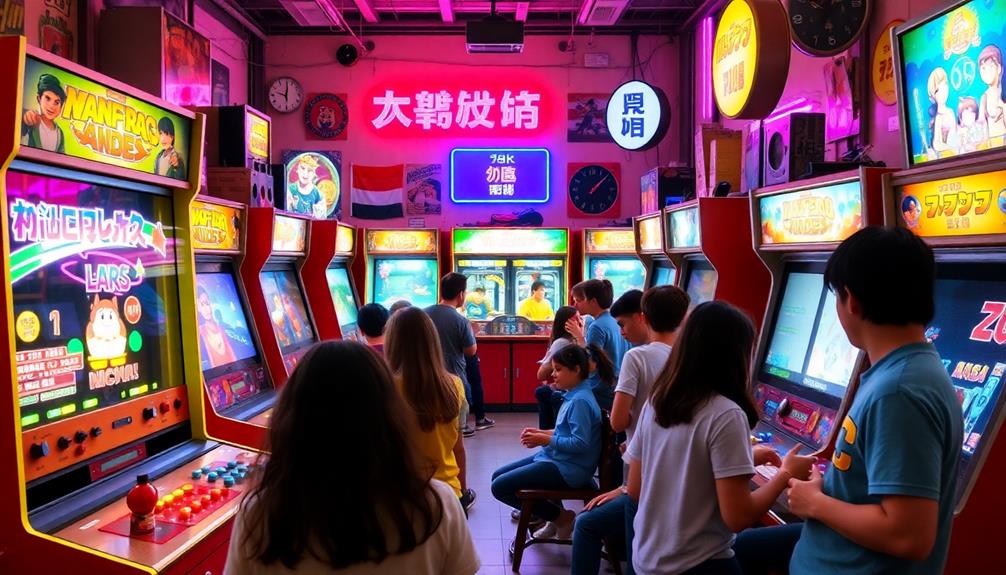
Offering a mix of nostalgia and excitement, popular arcade games continue to attract players of all ages. One standout title is PAC MAN, a classic that's captured hearts since its debut. You can enjoy it alongside other timeless favorites like Mortal Kombat II and NBA Jam, each deluxe edition priced at about $499.99.
For coffee enthusiasts, the vibrant energy from a freshly brewed cup can enhance your gaming experience, making those high scores feel even better. In fact, learning about various brewing methods can help you find the perfect cup to enjoy while playing.
If you're looking for something different, the Marvel Vs Capcom 2 X-Men 97 Edition lets you battle with iconic characters, while Big Buck Hunter Pro Deluxe offers a unique hunting simulation for 1-4 players at $599.99.
For a more family-friendly experience, consider the Infinity Game Table 32, priced at $999.99, which brings digital versions of classic board games into the arcade atmosphere.
Don't forget about redemption games like Skee-Ball, where you can win tickets for prizes, adding an extra layer of fun to your visit. These offerings not only evoke memories but also create new ones, ensuring that everyone leaves with a smile.
Whether you're challenging friends or enjoying solo gameplay, the variety in arcade games guarantees an engaging experience for everyone.
Pricing and Product Range
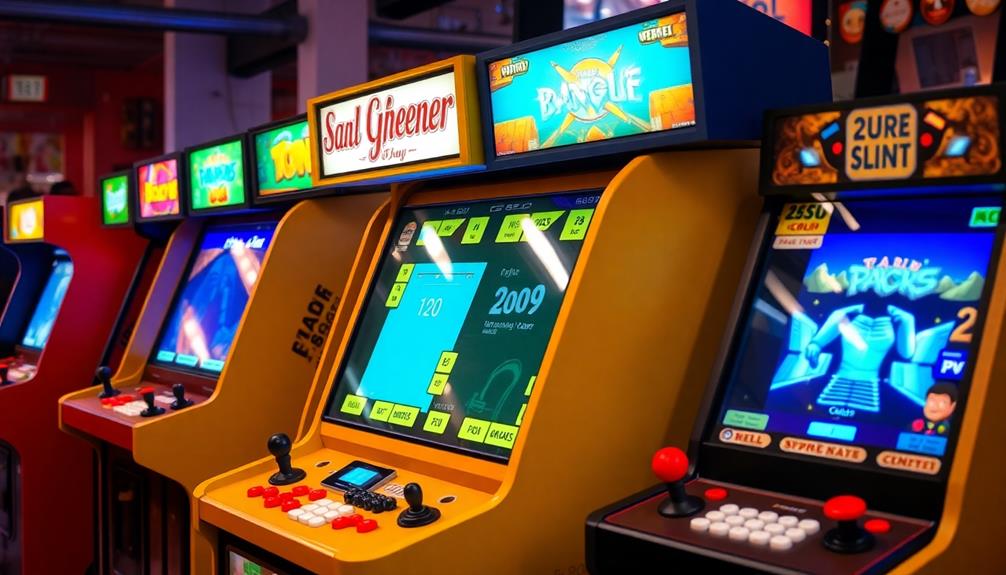
With a diverse array of arcade machines available, pricing can vary widely based on features and design. You'll find options that cater to different budgets and preferences, making it essential to evaluate your financial situation before making a purchase.
The range of 65 arcade products starts at an affordable $395.00, while high-end models can soar up to $48,999.00. Most arcade machines fall into the sweet spot of $3,000 to $5,000, with deluxe versions of popular games typically retailing around $20,999.00. If you're looking for commercial setups, coin-operated models generally range from $2,899.00 to $4,999.00.
Understanding the importance of creating a personal budget will help you allocate funds wisely for your arcade machine purchase.
Here are some key points to evaluate about pricing and product range:
- Classic games like Pac-Man, Ms. Pac-Man, and Galaga come in multiple styles.
- Options include upright and cocktail table versions for varied experiences.
- Full-size cabinets offer immersive gameplay for enthusiasts.
- Home editions are designed for personal enjoyment.
- A wide variety of game types means there's something for everyone.
Understanding this pricing landscape will help you choose the right arcade machine that fits your needs and budget.
Customer Engagement Strategies
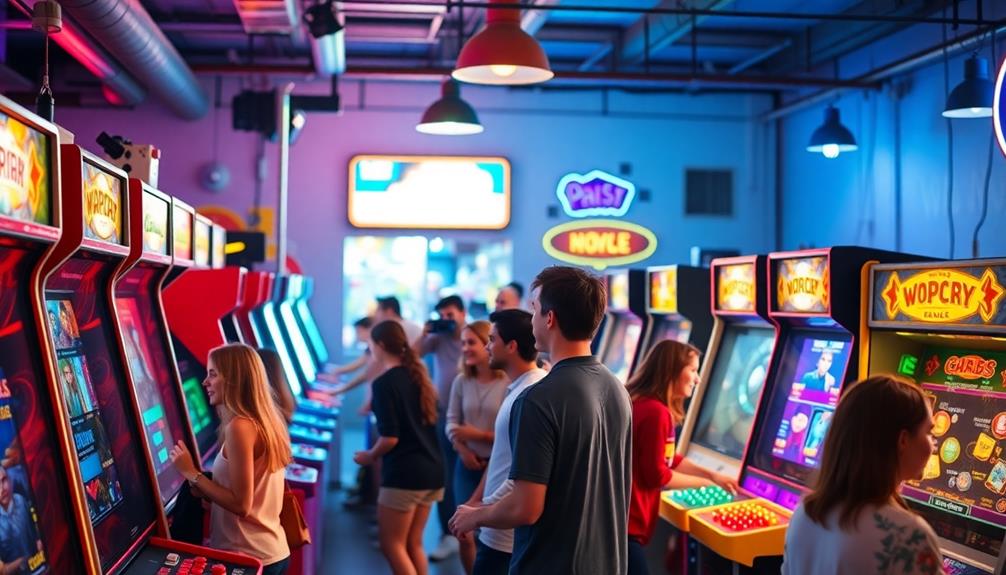
In today's competitive market, effective customer engagement strategies are essential for driving sales and building brand loyalty. One key approach is to highlight best-selling products, like your popular light gun arcade machines, to guide purchasing decisions. By showcasing these items, you not only attract potential buyers but also foster trust through product reviews and ratings.
Integrating interactive features, such as online games or demos, can markedly enhance customer engagement. These engaging elements encourage users to explore your offerings and envision themselves playing with the light gun, which can lead to increased interest and sales.
Additionally, implementing loyalty programs rewards repeat customers, further encouraging brand loyalty and repeat purchases.
Social media engagement is another powerful tool for promotion. By directly interacting with customers and sharing exciting content about your arcade games, you create a connected community that enhances brand loyalty.
Your "Order Now" campaign can drive immediate purchases of popular machines, instilling a sense of urgency among potential buyers. This combination of strategies not only boosts sales but also helps to establish a strong relationship with your audience, ensuring they keep coming back for more.
Frequently Asked Questions
Where Is the Arcade Game in Monty Golf?
You'll find the arcade game section after you finish your round of mini-golf at Monty Golf. It's a great way to unwind, featuring a mix of classic and modern games for everyone to enjoy.
What Is the Arcade Game Where You Dance?
You're talking about Dance Dance Revolution. It's a fun game where you step on a dance pad, matching arrows to the beat. You can choose songs and compete with friends, making it a lively experience!
What Is an Arcade Game Place Called?
An arcade game place is called an "arcade." You'll find various coin-operated games there, offering entertainment and social interaction. It's a perfect spot to enjoy classic and modern games with friends or family. Arcades often have a nostalgic atmosphere, with the flashing lights and sounds of the games creating an exciting and immersive experience. Additionally, finding the arcade game that you want to play can be part of the fun, as you explore the different options available. Whether you’re into racing games, classic arcade cabinets, or modern interactive experiences, there’s something for everyone to enjoy at an arcade.
What Is the Arcade Game Where You Hit the Lights?
You're looking for that game where you smack lights, right? It's not about being gentle—it's Whac-A-Mole! You'll whack away at those popping moles, scoring points while your reflexes dance in delight.
Conclusion
To sum up, arcade games have come a long way, blending skill and chance to keep players coming back for more. Did you know that over 30% of gamers still enjoy visiting arcades regularly? This highlights the enduring appeal of these vibrant spaces. As technology evolves and trends shift, arcades continue to adapt, offering exciting new experiences. So, whether you're a seasoned player or a curious newcomer, there's always something thrilling waiting for you at the arcade!
